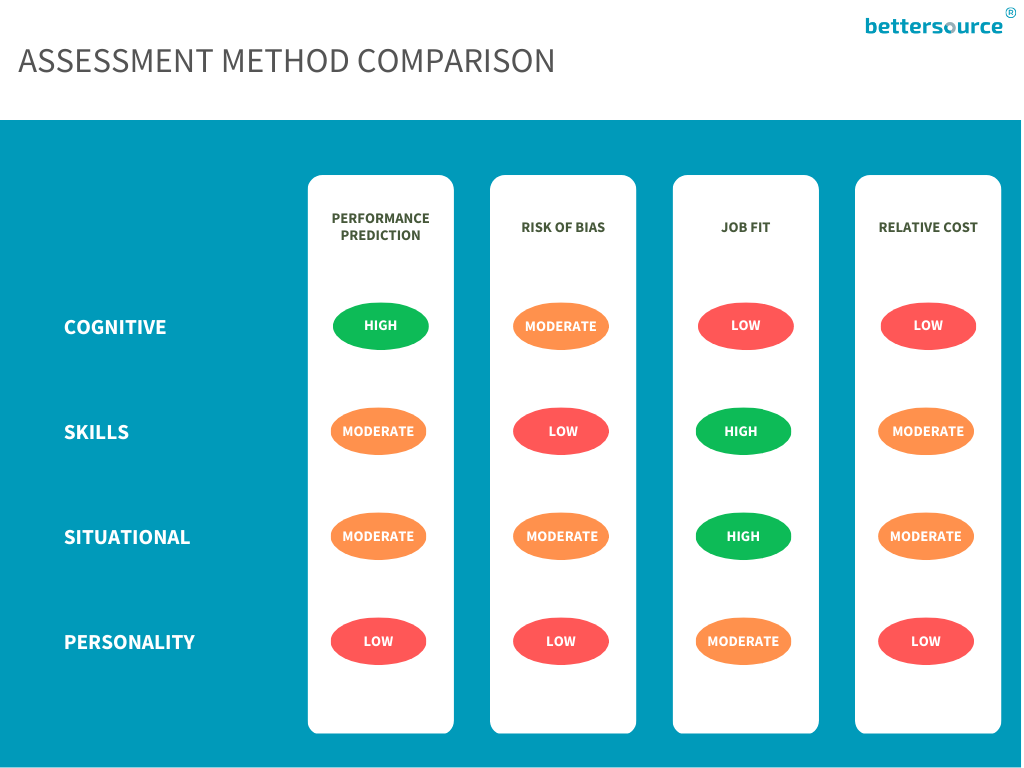The four major assessment techniques in recruitment

Our global hiring solution promises clients the same, if not higher, quality of talent as compared to in-house options. To identify the best candidates, we have instituted a rigorous, multi-stage selection process that includes multiple assessments and interviews.
In this article, we explain why we prioritise task-based assessments, used in conjunction with ‘traditional’ tools like resumes and interviews, to identify high performers.
The four main assessment types, according to Bettersource
The fundamental reason for using any assessment or test during the recruitment process is to reduce, as much as possible, subjective judgements that inevitably flow from resumes and interviews. Questions or tasks used in assessments yield discrete outcomes. For example, correct or incorrect answers, specific personality traits, and competency level for a particular skill. This can provide more reliable insights about potential job fit, and help avoid the significant costs of a bad hire.
That’s all well and good, but what types of assessment are out there? This is a subjective matter, and the answer usually depends on who you ask, because there is a fair amount of overlap between the many kinds of assessment used. We have found it useful to classify assessments by four broad categories, based on what aspect of the candidate’s suitability is being judged.
Cognitive ability assessment
Tests to measure cognitive ability, or general intelligence, are frequently and widely used in the recruitment process globally. They evaluate how well candidates are able to employ various mental processes such as numerical reasoning, reading comprehension, problem solving, and abstract thinking. Assessing cognitive ability is important to try and predict how well a candidate would likely follow instructions, navigate training, or communicate with coworkers.
Pros
- High predictive power. There has been a lot of social science research conducted on examining the link between cognitive ability and job performance. By and large, the consensus seems to be that a strong positive association exists between the two, making cognitive ability assessments a must-include component in the recruiting process.
- Precise and repeatable. Tests of general intelligence or ‘aptitude’ are highly precise and reliable, made so over decades of fine-tuning and administering. In particular, they are reliable because evidence has shown that candidates would achieve roughly the same results if re-assessed.
- Relatively low-cost. With these assessments now being administered mostly online, and being offered by various firms in an increasingly competitive market, assessing candidates for their cognitive ability can be done fairly inexpensively. This is especially true when compared to other methods such as in-person interviews and assessment centres.
Cons
- Unintended bias. In some cases, cognitive ability assessments can have the unintended consequence of being racially or ethnically discriminatory, leading to bias in the recruitment process. For instance, this can occur when economically disadvantaged minorities with relatively poorer educational outcomes compete with non-minorities, as has been studied with the respect to SAT tests.
- Limited insight for managerial roles. Defined broadly, leadership positions require both ‘hard’ (a proxy for cognitive ability) and soft skills – such as emotional intelligence. Industry and people management experience also become more important with seniority, abilities that cannot be judged through cognitive assessments.
Skills assessment
Recruiters need to find out whether candidates possess the right skills and requisite knowledge for the job. In other words, they need to be sure not only that the credentials supplied by candidates on their resumes are accurate, but also how good they are at those things. This is akin to asking aspiring actors to audition for a role, as is the norm, instead of just going by their portfolios.
Pros
- Better job fit. Perhaps the most important benefit of assessing skills is that it provides a chance for candidates to prove beyond any doubt that they know what they are doing. For instance, a well-designed test for a software developer might provide a piece of code to be fixed, or an aspiring content writer be asked to draft a short essay. In each case, their actual output will make it clear how competent they are at their trade, and how well-suited to the prospective job.
- Transparency and comparability. The unique thing about testing for skills is that the results can be standardised, hence giving more transparency to the hiring process. All candidates being assessed for the same skill in the same way helps achieve this, which reduces the possibility of subjective judgement. An added benefit is that the results of specific skills tests are comparable across candidates, in a way that personality assessments, for example, are not.
Cons
- Narrow focus. Compared to cognitive ability assessments, skills testing can have somewhat lower applicability. This is because general intelligence can be applied to various aspects of a job, but expertise in a particular skill usually cannot. In addition, the actual test being used to assess a skill might be outdated or not very relevant, so it’s important to spend some time and effort on designing it well.
- Requires frequent updation. It follows from the last point made above that to get the most out of skills assessments, they need to be tailor-made to specific jobs. This means that using skills tests in the recruitment process can drive up its overall cost, accounting for the extra hours frequently spent on designing them or relying on an external service provider.
Situational assessment
Situational judgement tests are a type of psychometric assessment to evaluate a candidate’s competencies to pick the most appropriate action in a simulated workplace setting, based on a series of scenarios presented to them. They can be standardised or customised as necessary, and provide insight about whether a candidate’s behaviour fits with the hiring company’s expectations, based on a specific job.
Pros
- Broadcast job needs. A major reason for the mismatch between job requirements and employees is the inability to communicate the former at the recruitment stage. Job descriptions can only convey so much, and making situational assessments a part of the screening process can provide a realistic view into the potential role to the candidate. This can filter out the most motivated applicants, who then have an opportunity to demonstrate their job relevance.
- Higher retention. If more interested (and suitable) candidates are shortlisted through the recruitment process, it can be expected that they would also be more likely to stay longer in the job. Situational assessments can also help to set realistic expectations from the outset, which helps in generating higher job satisfaction and reducing turnover.
Cons
- Relatively complex. Compared to cognitive ability and skills, creating assessments to judge job-related situational awareness is more complex. To be reliable indicators of suitability, recruiters need to make sure that situational assessments are not left too broad, to prevent candidates from employing generic responses.
- Cultural bias. One reason for their complexity is that situational assessments need to guard against cultural bias, to which they are prone. For instance, a test that takes Western professional culture as an appropriate baseline for assessing professionalism, will likely unfairly disadvantage non-Western candidates who otherwise might be a good fit.
Personality assessment
This provides informative insights about how candidates’ personal traits and proclivities are likely to impact their behaviour at work. This can help recruiters in understanding how candidates might approach various tasks, coordinate with their peers, solve unexpected problems, and manage their emotions in a professional setting.
Pros
- Broad insights. Compared to the other three main types of assessments, tests of personality provide the broadest overall view of a candidate. Typically, these assessments yield a personality profile, which suggests both strengths and potential weaknesses, where it lies on the extroversion-introversion scale, any potential behavioural red flags, and so on. Once specific job fit factors have been assessment, a personality assessment can round off the overall evaluation of a candidate.
- Longer term planning. By gaining a better understanding of candidates’ personal traits, recruiters can judge their suitability not only for the job, but also about how well they might fit within the company’s culture. At the same time, potential future managers can be earmarked during the recruitment stage, if desirable leadership qualities are identified through personality tests.
Cons
- Relatively low relevance. The flip side of any kind of broad assessment is that it will have weak predictive power with respect to actual job performance. This is because personality assessments typically don’t judge job specific abilities, while they behavioural traits they uncover are more indirectly linked to the actual work to be performed.
- Candidate apprehension. Often times candidates may not be able to properly attempt personality tests because of nervousness or the novelty of the questions types. Additionally, recruiters need to be mindful of language or cultural barriers when designing or using personality assessments.
Picking the right flavours
A helpful analogy to sum up this article might be to say that creating the ‘right’ assessment set is like choosing the right proportion of various spices for a recipe. The specific requirements of a job, the frequency of hiring, and the broader talent strategy of the organisation are key considerations that need to be balanced during recruitment.
This needs to be done while considering the distinct advantages and potential drawbacks of each assessment method. To help recruiters do this, we have constructed a summary evaluation chart for each method based on its performance prediction, risk of bias, job fit, and relative cost.

Still have more questions about how to improve your talent pool? We would love to hear from you and discuss how Bettersource can help.









